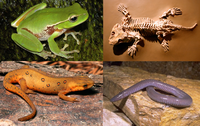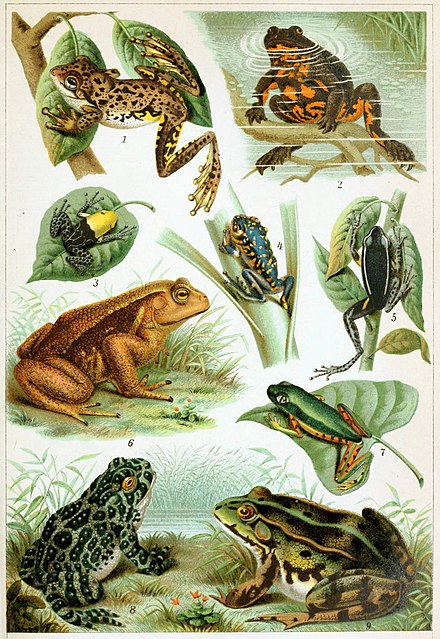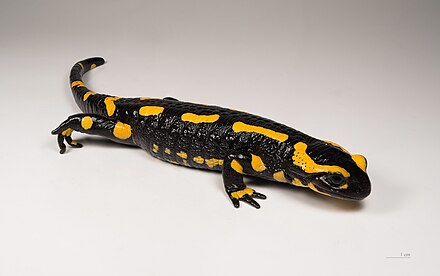User:The Transhumanist/Sandbox144
Introduction
Selected amphibian type
A frog is any member of a diverse and largely carnivorous group of short-bodied, tailless amphibians composing the order Anura (ἀνούρα, literally without tail in Ancient Greek). The oldest fossil "proto-frog" Triadobatrachus is known from the Early Triassic of Madagascar, but molecular clock dating suggests their split from other amphibians may extend further back to the Permian, 265 million years ago. Frogs are widely distributed, ranging from the tropics to subarctic regions, but the greatest concentration of species diversity is in tropical rainforest. Frogs account for around 88% of extant amphibian species. They are also one of the five most diverse vertebrate orders. Warty frog species tend to be called toads, but the distinction between frogs and toads is informal, not from taxonomy or evolutionary history.
An adult frog has a stout body, protruding eyes, anteriorly-attached tongue, limbs folded underneath, and no tail (the tail of tailed frogs is an extension of the male cloaca). Frogs have glandular skin, with secretions ranging from distasteful to toxic. Their skin varies in colour from well-camouflaged dappled brown, grey and green to vivid patterns of bright red or yellow and black to show toxicity and ward off predators. Adult frogs live in fresh water and on dry land; some species are adapted for living underground or in trees.
Frogs typically lay their eggs in water. The eggs hatch into aquatic larvae called tadpoles that have tails and internal gills. They have highly specialized rasping mouth parts suitable for herbivorous, omnivorous or planktivorous diets. The life cycle is completed when they metamorphose into adults. A few species deposit eggs on land or bypass the tadpole stage. Adult frogs generally have a carnivorous diet consisting of small invertebrates, but omnivorous species exist and a few feed on plant matter. Frog skin has a rich microbiome which is important to their health. Frogs are extremely efficient at converting what they eat into body mass. They are an important food source for predators and part of the food web dynamics of many of the world's ecosystems. The skin is semi-permeable, making them susceptible to dehydration, so they either live in moist places or have special adaptations to deal with dry habitats. Frogs produce a wide range of vocalizations, particularly in their breeding season, and exhibit many different kinds of complex behaviors to attract mates, to fend off predators and to generally survive. (Full article...)
Selected frog article
The Ceratophryidae, also known as common horned frogs, are a family of frogs found in South America. It is a relatively small family with three extant genera and 12 species. Despite the common name, not all species in the family have the horn-like projections at the eyes. They have a relatively large head with big mouth, and they are ambush predators able to consume large prey, including lizards, other frogs, and small mammals. They inhabit arid areas and are seasonal breeders, depositing many small eggs in aquatic habitats. Tadpoles are free-living and carnivorous (Ceratophrys and Lepidobatrachus) or grazers (Chacophrys).
Some species (especially from the genera Ceratophrys and Lepidobatrachus) are popular in herpetoculture.
The oldest fossils of the family are known from the Miocene epoch. The fossil giant frog Beelzebufo from the Late Cretaceous of Madagascar was formerly considered to belong to this family, but is now excluded, but is possibly closely related, alongside Baurubatrachus from the Late Cretaceous of Brazil. Wawelia from the Miocene of Argentina is no longer considered closely related. (Full article...)
Selected salamander article
The Cryptobranchoidea are a suborder of salamanders found in Asia, European Russia, and the United States. They are known as primitive salamanders, in contrast to Salamandroidea, the advanced salamanders. It has two living subdivisions, Cryptobranchidae (Asian giant salamanders and hellbenders), and Hynobiidae, commonly known as Asian salamanders.
Giant salamanders are obligate paedomorphs with partial metamorphosis, but Asiatic salamander goes through a full metamorphosis. The only known exceptions are the Longdong stream salamander, which has been documented as facultatively neotenic, and the Ezo salamander, where a now assumed extinct population from Lake Kuttarush in Hokkaido had neotenic traits like gills in adults.
The oldest members of the group are known from the Middle Jurassic (Bathonian) aged Yanliao Biota of China. (Full article...)
The page "User:The Transhumanist/Sandbox144/box-header" does not exist. The page "User:The Transhumanist/Sandbox144/DYK/4" does not exist.
Picture slideshow
Selected toad article
Large-crested toad is a common name for several amphibians and may refer to:
- Incilius cristatus, native to Puebla and Veracruz in Mexico
- Incilius macrocristatus, native to Guatemala and Chiapas in Mexico (Full article...)
Selected caecilian article

The Grandisoniidae are a family of common caecilians found in Africa, Seychelles and India. Like other caecilians, they superficially resemble worms or snakes. The family was formerly known as Indotyphlidae. (Full article...)
Categories
Topics
Related portals

Salamanders
Frogs and toads
Paleontology
Extinct and Endangered Species
Paleozoic
Mesozoic
Cenozoic
Reptiles
Birds
Associated Wikimedia
The following Wikimedia Foundation sister projects provide more on this subject:
-
Commons
Free media repository -
Wikibooks
Free textbooks and manuals -
Wikidata
Free knowledge base -
Wikinews
Free-content news -
Wikiquote
Collection of quotations -
Wikisource
Free-content library -
Wikiversity
Free learning tools -
Wiktionary
Dictionary and thesaurus


1.JPG/440px-Argentine_Horned_Frog_(Ceratophrys_ornata)1.JPG)



_jeannaea.jpg/440px-BennyTrapp_Cädiz-Scheibenzüngler_bzw_Iberischer_Scheibenzüngler_Discoglossus_(galganoi)_jeannaea.jpg)








.jpg/440px-Fire_Bellied_Toad_-_CNP_3431_(7138473433).jpg)








.jpg/440px-Agile_frog_(Rana_dalmatina).jpg)






.jpg/440px-Саламандра_вогняна_(Salamandra_salamandra).jpg)





_crop.jpg/440px-Australia_green_tree_frog_(Litoria_caerulea)_crop.jpg)

.jpg/440px-Dendropsophus_microcephalus_-_calling_male_(Cope,_1886).jpg)







